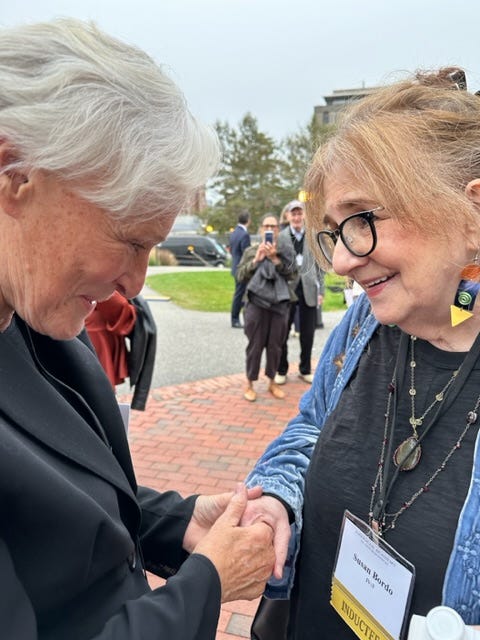“I see you’re coloring your hair too,” she said. The topic was a relief—although I proudly replied “No, this is my color” (ignoring for that moment some not-me streaks.) The last time we spoke—some 24 years ago—she had lectured me sternly, in her deceptively soft voice, about my politics. She didn’t believe it was right for white people to adopt Black infants. Up until then, we’d been good friends. Girl-bonding was one of the things that had made being in academia tolerable for me. Whatever our political or ideological differences, we could always get together over experiences with penises and/or vaginas, both theoretical and actual. The stereotypes of stone-faced feminists have always got it wrong. Most of my generation was sex-crazed. And funny. And fun to be with. I realized, seeing her again, that we could probably be good friends again.
And now we were apparently distinguished scholars, too. I still think my election to the American Academy of Arts and Sciences was some kind of weird (but thrilling) wrinkle. In any case, I was probably the only academic in there who didn’t know what I was a distinguished scholar of. They needed a category for “Promiscuously Hybrid.” Every time someone, seeing the yellow ribbon under my name tag that signaled I was an inductee, asked what my field was I was stumped. “Uh…cultural studies?” Then, seeing a lot of blank stares, I would usually babble on a bit about gender, media, popular culture, whatever came to mind at the moment.
I’m not kidding (as our POTUS would say.) The Academy had put me under “Literature and Language Studies.” But when they called the “Philosophy” division to the stage, a woman sitting in my row leaned over: “Shouldn’t you be up there?” Yeah, I don’t know, maybe. That was my doctoral degree. But I was happy sitting next to the Professor of Jewish Culture who is writing a book about Philip Roth (rather than, say, Lacan.) It was a cozy surprise, to be asked what streets I’d lived on in Newark—and he recognized all of them. I was glad to have someone to think silent “oys” with when the men in kilts came down the aisles.
They had bagpipes. They were playing them. It was very, very loud and I was on the aisle seat. Culture shock of some unspecifiable sort. They were playing a medley of Americana tunes. But bagpipes? And why “America the Beautiful”? Was it some sort of “fuck you” to the MAGAs? (As in: This country is ours, you dumb shits.) Or just meant to awaken the dozing? I was a good inductee and resisted putting my hands over my ears.
After that, there was more Americana, sung by the enthusiastic, extremely precious Boston Children’s Chorus, and I realized the musical theme probably had to do with the founding of the organization, during the American Revolution, by John Adams, John Hancock, and other prominent “scholar-patriots” who “contributed to the establishment of the new nation, its government, and its Constitution.”
Today, the American Academy of Arts and Sciences is “an international learned society that brings together individuals from every field and profession to anticipate, examine, and confront the critical issues facing our global society.” This year, because of a skipped pandemic year, there were twice as many of us as usual—a parade of inductees which was both endless (three hours) and fascinating. I was sure my daughter, up there somewhere in the back, was counting off the divisions. But for me, the ceremony revived something we all know—in theory—but that rarely hits me the way it did as I sat and watched inductee after inductee walk across the stage.
So many individual lives full of so many different accomplishments, every one of them a center of consciousness of a whole, unique, completely engaging world for that person. It’s true of everyone on the face of the earth, but how often do we actually have our attention drawn to it? When I was a child, it amazed me to think about it: the fact that no two people see the same world…but that what each of us sees is a whole world, a complete world. I’d lie on my bed and think about it until I felt myself swallowed up by the enormity of it. Then I grew up, and mostly stopped pondering such things. But seeing so many of those different worlds being celebrated as worlds revived that wonder in me.
Some of you read my last piece, “The Stairs,” in which I shared my anxiety over the challenge to my aging back (and ageless narcissism) of lumbering up rail-less stairs to the stage, where every inductee would shake hands with the President of the Academy and Members of the Board and sign their names in the Big Book. Like much in my life, I spent way too much time worrying about it. (1) There were rails; (2) The stairs themselves were behind the stage, so any awkward hauling of body was hidden; (3) Muscle memory from the hundreds of stages I’d walked across during my life took over.
It was fine. (A big thank you to all who reassured me it would be.) My division, whether or not I belonged in it, was definitely the best dressed. My daughter Cassie may have been lying when she told me mine was not the biggest butt to walk across the stage, but I loved her for it anyway. My sister-in-law Terry may have been lying when she told me I “positively glided” across the stage, but I loved her for it anyway. I celebrated by having very expensive gnocchi in two different restaurants two nights in a row.
Famous People Report:
Because of the train schedule we had missed the opening talk on Friday night. But I did have a fangirl moment in the elevator. I was loopy, with back and feet hurting from shlepping with luggage and many travel hours and wine with dinner, so at first I didn’t notice that also in the elevator was a very tall man with a hat—until my husband (also very tall but no hat) said “You’re John Lithgow.”
It was. I apologized for missing his talk (as though he could care!) and don’t remember what I babbled when he asked about my field. I do remember that as we left the elevator my mind spewed out into my mouth that I liked him best as a serial killer. I thought I saw his brow furrow, and that he said something like “there won’t be any more of those.” (I can’t be sure as we were out the elevator door at that point.)
Ack, something new for Susan to worry about! But the next morning at the breakfast reception, he was lovely and gracious and John, if you happen to be reading this: I actually think you were miraculous in every role (and I’ve seen them all.) But it’s true that The Trinity Killer holds a special place in my heart. That, and when you told the cashier in “Terms of Endearment” that she was a rude young lady.
And then there was Glenn Close. I love this picture because she’s holding my hand and we look like buddies. Actually, I believe at the moment that this picture was taken, she was looking down at my name tag and asking me about my field. And I was babbling incoherently about it, as usual. Someday I’ll learn to just say one thing—anything!—and then shut up.
I looked for Laurence Fishburne, too, but he wasn’t to be found and subjected to my fangirling.
(If you missed my pre-induction anxiety post:
The Stairs
I don’t fret much about looking old. That may be mostly because I don’t. Being a little bit fat most of my life has given my face natural filler. My red hair, which I would have liked to get rid of as an adolescent (glamour then being blonde and blue-eyed) has had its revenge and has never gone grey, and I have a lot of i…
Stay tuned for the return to my more normal newsletters. Next up: a kedgeree of movies you might not have seen and should. (I’ll also explain what a kedgeree is.)








"Why are there bagpipes?" is always a question worth posing. One summer at music camp, bagpipes blew reveille. I do not recommend.
Congratulations! You deserve this accolade and many more.
Congratulations! 👏🏻Well deserved honor—I wish that I would have had you as a professor. I love reading your essays—very thought provoking.